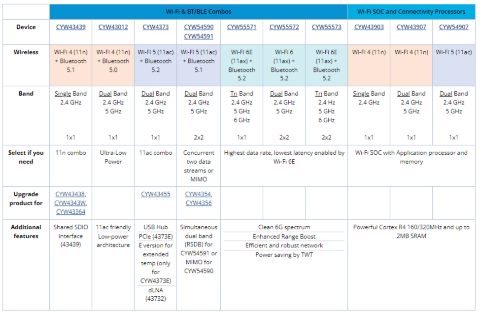AIROC™ Wi-Fi and Wi-Fi+Bluetooth® Combo
Broad family of secure, robust solutions that enable you to bring great products to market faster
AIROC™ Wi-Fi and Wi-Fi+Bluetooth® Combo Unterkategorien
Infineon’s AIROC™ Wi-Fi & combos portfolio integrates IEEE 802.11a/b/g/n/ac/ax Wi-Fi and Bluetooth® 5.4 in a single-chip solution to enable small-form-factor IoT designs. Combo, standalone Wi-Fi, and Wi-Fi SoCs with embedded MCU and on-chip networking capabilities are also offered in 1x1 SISO and 2x2 MIMO configurations. Wi-Fi and combo solutions can be coupled with external MCUs from Infineon and others for RTOS, along with Linux on application processors to implement a complete Wi-Fi + Bluetooth®/Bluetooth® Low Energy system.
AIROC™ Wi-Fi SoCs include on-chip MCUs, memory, and the networking protocols required for customers to easily create their own cloud-connected applications.
Infineon’s ModusToolbox™ software and tools provides code examples and development support for Wi-Fi SoCs or adding Infineon’s secure and low-power PSoC™ MCUs and sensors to IoT applications. Infineon also supports our customers through our global network of IoT partners using production-ready, fully-certified AIROC™ Wi-Fi & combo modules based on both Linux and RTOS based platforms.
Infineon has created a flexible ecosystem allowing us to offer complete AIROC™ Wi-Fi and AIROC™ Bluetooth Linux solutions designed to address the evolving requirements of the embedded connectivity market.
Proprietary and Open Source Linux packages have now evolved which leverage our partner ecosystem and the Linux open source community.
Specifically, within the proprietary Linux support model, the CPU manufacturer will provide the Linux Kernel, associated device drivers, evaluation platform and all necessary support for the same as part of a standard Linux release process. The production module supplier will then support the production Cypress based Wi-Fi/Bluetooth module which interfaces to the board via a connector, or resides directly on their intended development platform.
Conversely, the new Linux Open Source model enables the use of any host architecture and platform supported by kernel.org (open source FMAC Linux driver). By leveraging the open source community, the open source (example: Quick Start with FMAC Driver on iMX6 UVELK and Murata 1DX) driver is able to iterate, innovate and improve more quickly than closed-source alternatives, as a result of exposure to a broader audience and broader set of use-cases. Finally, the integration of the open source driver will be facilitated by the open source community that is becoming more adept at supporting this process.




